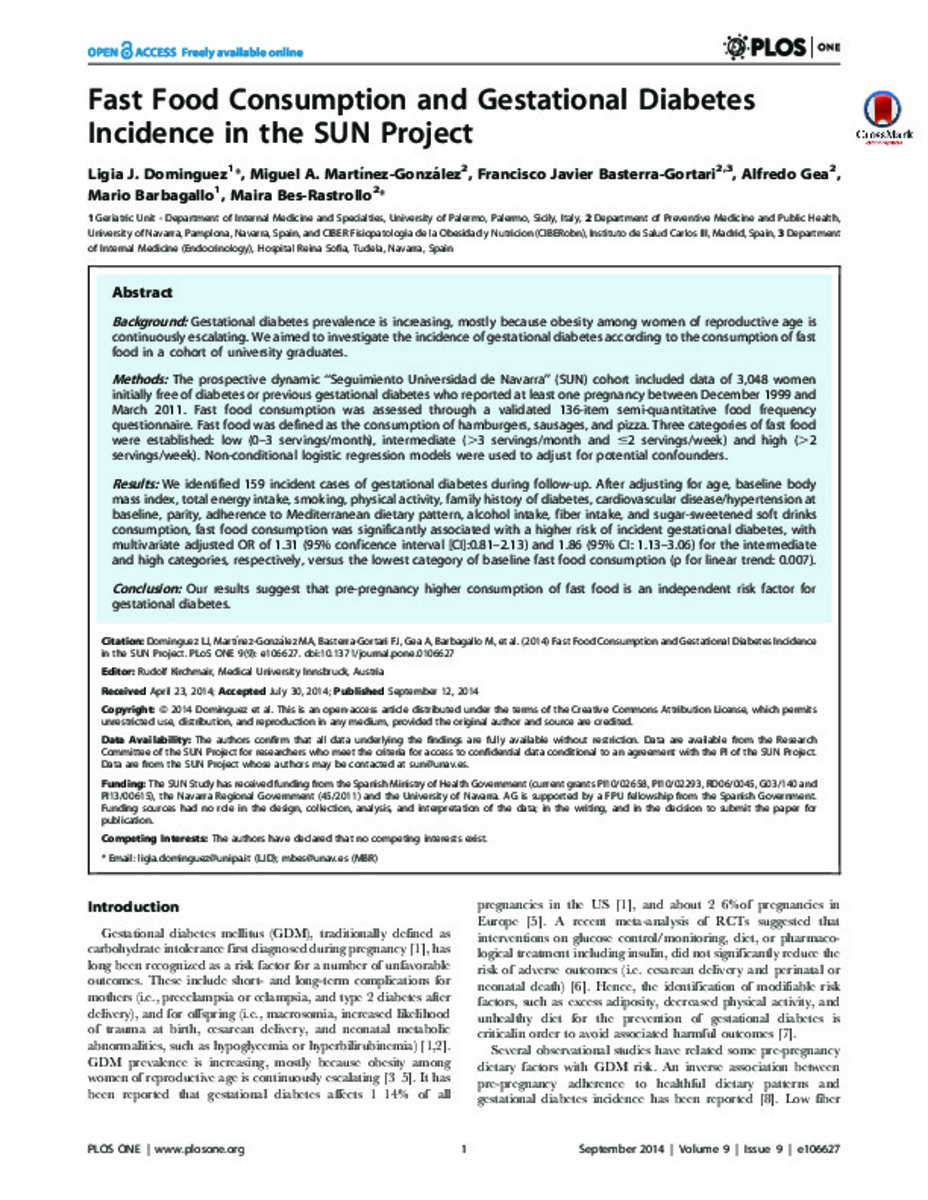Full metadata record
| DC Field | Value | Language |
|---|---|---|
| dc.creator | Dominguez, L.J. (Ligia J.) | - |
| dc.creator | Martinez-Gonzalez, M.A. (Miguel Ángel) | - |
| dc.creator | Basterra-Gortari, F.J. (Francisco Javier) | - |
| dc.creator | Gea, A. (Alfredo) | - |
| dc.creator | Barbagallo, M. (Mario) | - |
| dc.creator | Bes-Rastrollo, M. (Maira) | - |
| dc.date.accessioned | 2014-11-07T19:21:22Z | - |
| dc.date.available | 2014-11-07T19:21:22Z | - |
| dc.date.issued | 2014 | - |
| dc.identifier.citation | Dominguez LJ, Martínez-González MA, Basterra-Gortari FJ, Gea A, Barbagallo M, Bes-Rastrollo M. Fast food consumption and gestational diabetes incidence in the sun project. PLoS One. 2014 Sep 12;9(9):e106627 | es_ES |
| dc.identifier.issn | 1932-6203 | - |
| dc.identifier.uri | https://hdl.handle.net/10171/37031 | - |
| dc.description.abstract | Background: Gestational diabetes prevalence is increasing, mostly because obesity among women of reproductive age is continuously escalating. We aimed to investigate the incidence of gestational diabetes according to the consumption of fast food in a cohort of university graduates. Methods: The prospective dynamic ‘‘Seguimiento Universidad de Navarra’’ (SUN) cohort included data of 3,048 women initially free of diabetes or previous gestational diabetes who reported at least one pregnancy between December 1999 and March 2011. Fast food consumption was assessed through a validated 136-item semi-quantitative food frequency questionnaire. Fast food was defined as the consumption of hamburgers, sausages, and pizza. Three categories of fast food were established: low (0–3 servings/month), intermediate (.3 servings/month and #2 servings/week) and high (.2 servings/week). Non-conditional logistic regression models were used to adjust for potential confounders. Results: We identified 159 incident cases of gestational diabetes during follow-up. After adjusting for age, baseline body mass index, total energy intake, smoking, physical activity, family history of diabetes, cardiovascular disease/hypertension at baseline, parity, adherence to Mediterranean dietary pattern, alcohol intake, fiber intake, and sugar-sweetened soft drinks consumption, fast food consumption was significantly associated with a higher risk of incident gestational diabetes, with multivariate adjusted OR of 1.31 (95% conficence interval [CI]:0.81–2.13) and 1.86 (95% CI: 1.13–3.06) for the intermediate and high categories, respectively, versus the lowest category of baseline fast food consumption (p for linear trend: 0.007). Conclusion: Our results suggest that pre-pregnancy higher consumption of fast food is an independent risk factor for gestational diabetes. | es_ES |
| dc.language.iso | eng | es_ES |
| dc.publisher | Public Library of Science | es_ES |
| dc.rights | info:eu-repo/semantics/openAccess | es_ES |
| dc.subject | Gestational diabetes | es_ES |
| dc.subject | Fast food | es_ES |
| dc.subject | SUN Project | es_ES |
| dc.title | Fast food consumption and gestational diabetes incidence in the SUN project | es_ES |
| dc.type | info:eu-repo/semantics/article | es_ES |
| dc.identifier.doi | http://dx.doi.org/10.1371/journal.pone.0106627 | es_ES |
Files in This Item:
Statistics and impact
Items in Dadun are protected by copyright, with all rights reserved, unless otherwise indicated.






